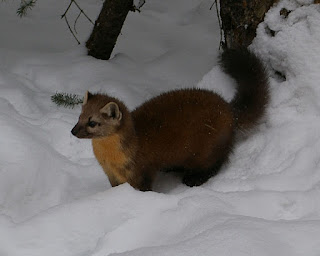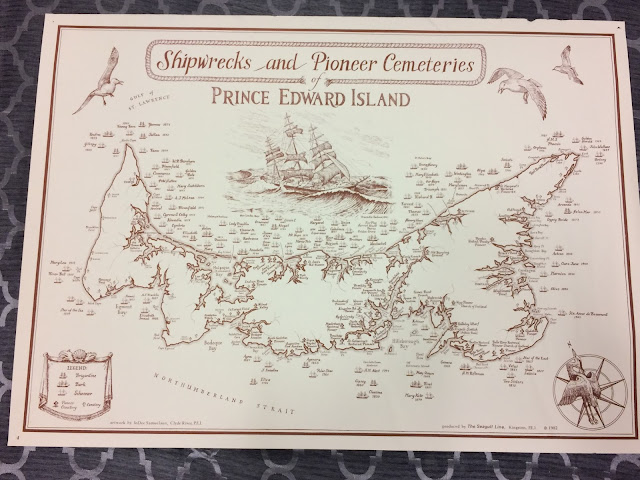Extirpated Animals of PEI
PEI is full of animals. Some are very common, such as foxes, raccoons, rabbits, and beavers. Others are extinct or extirpated. Extinction is when the animal is no longer found anywhere, like a dodo or passenger pigeon. Extirpation is when an animal is no longer found in a certain area. So what kind of animals from PEI have been extirpated - no longer found on PEI but are still found elsewhere? It is actually pretty surprising!
I should note, that according to Doug Sobey, we have a habit of believing extirpated animals are around for longer than they actually are. After all, just because you do not see an animal does not mean it is no longer around. So remember that when we look at dates in this post.
1. Martens
Martens, or Martes Americana, are mentioned in early English and French records and their fur was valuable. But, by the late nineteenth century, they are no longer mentioned in records.
2. Caribou
I am not going to go into too much detail here as I wrote an entire blog post on the Island caribou and their disappearance. By 1775, there were no records of caribou. As more settlers came, they experienced severe habitat loss and hunting. If you want to know more about Island caribou, you can check my PEI Caribou: What Happened? post.
3. Black Bears
When Europeans arrived on PEI, there was a large number of black bears overall. But, because farmers at the time allowed their livestock to roam free, bears became a big problem. So in the 1790's, a bounty of 15 shillings was placed on them. Between 1820 and 1861, thousands of bears were killed for the bounty.
Black bears are very adaptive creatures so they were able to adapt and survived until 8 February 1927 when the last one was killed near the Souris Line Road.
4. Lynx
Yes, we had lynx on PEI! Like bears, they had a habit of attacking livestock so a bounty was placed on them in the 1820's. The bounty for lynx was lower than the one for bears, at only 5 shillings each. Between 1820 and 1861, an estimated 357 lynx bounties were collected. By 1890, they seem to have disappeared.
5. Wolf
If you read my PEI Caribou: What Happened? post, you will know that wolves are the greatest predator of caribou. So where you find caribou, you usually find wolves. While there is plenty of sources that look at caribou on the Island, there are fewer sources that look at wolves. In 1721, these wolves were reported as being a "prodigious size" and a pelt was sent to France. After that, it is hard to find sources about them. They likely disappeared due to habitat loss, lack of caribou, and hunting. Europeans did not like anything hunting their livestock, so wolves would not have been safe from them.
6. River Otters
Otters are believed to have been commonly found in the bays of PEI during French settlement on the Island. But, their fur was highly prized and they quickly disappeared. I could not find a date for when they disappeared.
The good news is that they are still sometimes found here as it seems they sometimes make the trip from Nova Scotia or New Brunswick. Sometimes these otters become stuck in beaver traps.
As you can see from this list, three of our extirpated animals are predators. While these animals were dangerous for humans and livestock, they also helped with things like population control as they ate the slow and weak and kept the population from going out of control and kept herds healthy. They forced prey to constantly move which helps keep habitats from becoming overpopulated and overused. Just looked at what happened when wolves were reintroduced to Yellowstone Park (and no, I am not recommending we reintroduce wolves to PEI, just to clarify). This video from Sustainable Human demonstrates the importance of predators.
Whereas Mi'kmaq had been able to live with these predators and smaller animals for centuries, environmental journalist Zach Metcalfe put it best, "...our province's European settlers made no effort to co-exist with Island predators." But, we know they have a role. Sometimes, like in the video above, that is a good thing. Other times, if they are too close to humans, humans react.
Of course, this list only includes some of the animals no longer found on PEI, but the list of threatened/endangered animals on PEI is growing. Currently, this list also includes Bank and Barn Swallows, Lumpfish, Monarch Butterfly, and Piping Plover, just to name a few. The list also does not take the ones that are considered to be of "special concern" into account.
Diverse ecosystems are good for the environment and humans (unless it is an invasive species...that is entirely different). All animals and species found on the Island have a purpose, even those annoying bloodsuckers (AKA mosquitoes). And I say that after growing up on the East end of the Island in the country.
"Species at Risk." Children in Nature PEI. March 22, 2012. http://childreninnaturepei.ca/speciesatrisk
I should note, that according to Doug Sobey, we have a habit of believing extirpated animals are around for longer than they actually are. After all, just because you do not see an animal does not mean it is no longer around. So remember that when we look at dates in this post.
1. Martens
 |
| Cute. (Image Credit: Wikipedia) |
Martens, or Martes Americana, are mentioned in early English and French records and their fur was valuable. But, by the late nineteenth century, they are no longer mentioned in records.
2. Caribou
 |
| Caribou. Their antlers were sometimes mistaken for moose, leading to the belief that PEI once had moose. (Image Credit: CBC News) |
I am not going to go into too much detail here as I wrote an entire blog post on the Island caribou and their disappearance. By 1775, there were no records of caribou. As more settlers came, they experienced severe habitat loss and hunting. If you want to know more about Island caribou, you can check my PEI Caribou: What Happened? post.
3. Black Bears
 |
| The cubs look adorable! (Image Credit: RCI) |
When Europeans arrived on PEI, there was a large number of black bears overall. But, because farmers at the time allowed their livestock to roam free, bears became a big problem. So in the 1790's, a bounty of 15 shillings was placed on them. Between 1820 and 1861, thousands of bears were killed for the bounty.
Black bears are very adaptive creatures so they were able to adapt and survived until 8 February 1927 when the last one was killed near the Souris Line Road.
4. Lynx
 |
| Canadian lynx. (Image Credit: Canadian Wildlife Federation) |
Yes, we had lynx on PEI! Like bears, they had a habit of attacking livestock so a bounty was placed on them in the 1820's. The bounty for lynx was lower than the one for bears, at only 5 shillings each. Between 1820 and 1861, an estimated 357 lynx bounties were collected. By 1890, they seem to have disappeared.
5. Wolf
 |
| Not to be mistaken with the coyotes on PEI. Wolves tend to be bigger. (Image Credit: HSI) |
If you read my PEI Caribou: What Happened? post, you will know that wolves are the greatest predator of caribou. So where you find caribou, you usually find wolves. While there is plenty of sources that look at caribou on the Island, there are fewer sources that look at wolves. In 1721, these wolves were reported as being a "prodigious size" and a pelt was sent to France. After that, it is hard to find sources about them. They likely disappeared due to habitat loss, lack of caribou, and hunting. Europeans did not like anything hunting their livestock, so wolves would not have been safe from them.
6. River Otters
 |
| River Otter. Whatever it's looking at, it doesn't look impressed (Image Credit: Healthy Wildlife) |
Otters are believed to have been commonly found in the bays of PEI during French settlement on the Island. But, their fur was highly prized and they quickly disappeared. I could not find a date for when they disappeared.
The good news is that they are still sometimes found here as it seems they sometimes make the trip from Nova Scotia or New Brunswick. Sometimes these otters become stuck in beaver traps.
As you can see from this list, three of our extirpated animals are predators. While these animals were dangerous for humans and livestock, they also helped with things like population control as they ate the slow and weak and kept the population from going out of control and kept herds healthy. They forced prey to constantly move which helps keep habitats from becoming overpopulated and overused. Just looked at what happened when wolves were reintroduced to Yellowstone Park (and no, I am not recommending we reintroduce wolves to PEI, just to clarify). This video from Sustainable Human demonstrates the importance of predators.
Whereas Mi'kmaq had been able to live with these predators and smaller animals for centuries, environmental journalist Zach Metcalfe put it best, "...our province's European settlers made no effort to co-exist with Island predators." But, we know they have a role. Sometimes, like in the video above, that is a good thing. Other times, if they are too close to humans, humans react.
Of course, this list only includes some of the animals no longer found on PEI, but the list of threatened/endangered animals on PEI is growing. Currently, this list also includes Bank and Barn Swallows, Lumpfish, Monarch Butterfly, and Piping Plover, just to name a few. The list also does not take the ones that are considered to be of "special concern" into account.
Diverse ecosystems are good for the environment and humans (unless it is an invasive species...that is entirely different). All animals and species found on the Island have a purpose, even those annoying bloodsuckers (AKA mosquitoes). And I say that after growing up on the East end of the Island in the country.
Daoust, Pierre-Yves. "Accidental Bycatches Identify Rare Returns of River Otters to PEI." Canadian Wildlife Health Cooperative. December 11, 2017. http://blog.healthywildlife.ca/accidental-bycatches-identify-rare-returns-river-otters-pei/
"Extinct to PEI." MacPhail Woods Ecological Forestry Project. https://macphailwoods.org/nature-guides/mammals/extinct-to-pei/
Metcalfe, Zack. "Huge wolves, caribou and bears once roamed PEI's old growth forests." The Guardian. September 30, 2017. http://www.theguardian.pe.ca/news/local/huge-wolves-caribou-and-bears-once-roamed-peis-old-growth-forests-105180/"Species at Risk." Children in Nature PEI. March 22, 2012. http://childreninnaturepei.ca/speciesatrisk


Comments
Post a Comment